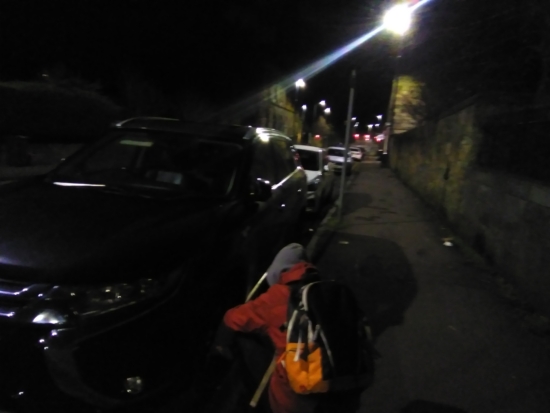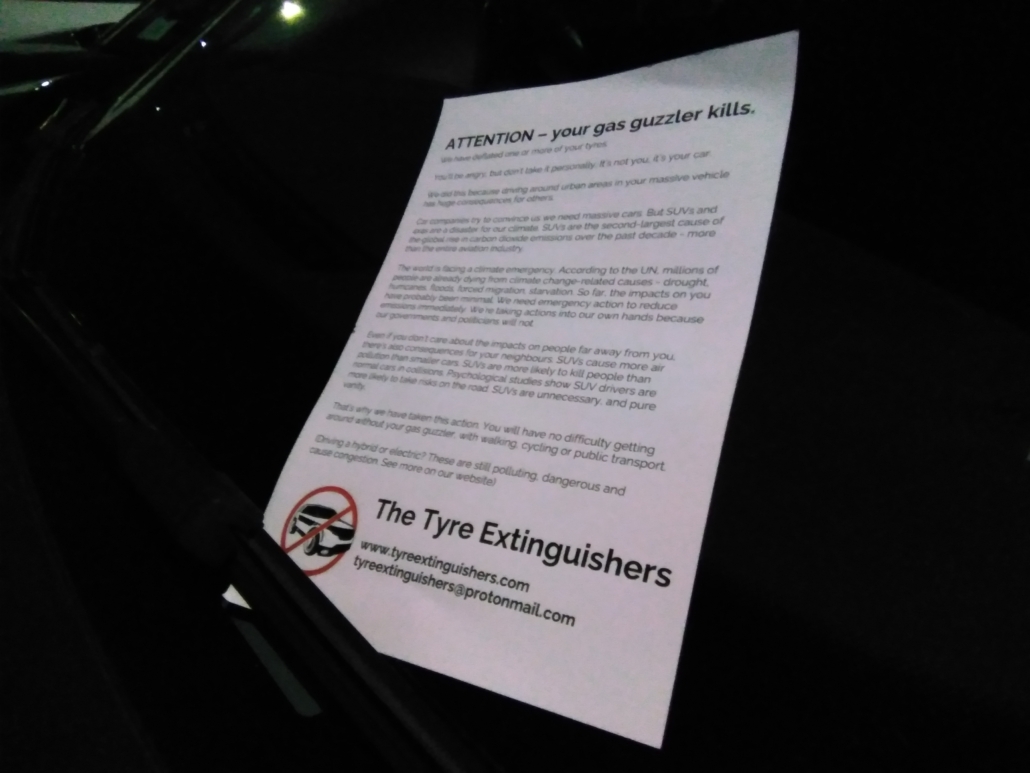‘Tyre Extinguishers’ deflate 100s of SUV tyres across 13 UK locations
 The Tyre Extinguishers are encouraging the public to protest against SUVs, but are they aware of the environmental and road safety risks of interfering with tyre pressures? (Photo: The Tyre Extinguishers)
The Tyre Extinguishers are encouraging the public to protest against SUVs, but are they aware of the environmental and road safety risks of interfering with tyre pressures? (Photo: The Tyre Extinguishers)
A campaign group made up of anonymous climate change activists reports that it has deflated the tyres of hundreds of SUVs across more than 13 locations in the UK. The group, which calls itself “The Tyre Extinguishers” claims that it “disarmed” SUVs in Chelsea, Chiswick, Harley Street, Hampstead Heath, Notting Hill, Belgravia, Clapham, Brighton, Bristol, Cambridge, Sheffield, Liverpool and Edinburgh on the evening of 7 March 2022. However, it is less clear whether they considered the safety and indeed environment implications of such vehicles driving on underinflated tyres.
The Tyre Extinguishers aim “to make it impossible to own an SUV in the UK’s urban areas” on the basis that “SUVs are unnecessary ‘luxury emissions’, flaunted by the wealthy, that are a climate disaster, cause air pollution and make our roads more dangerous.”
Nevertheless, The Tyre Extinguishers, which described itself as a “leaderless group where citizens take action in their local area…” because SUVs are “a climate disaster”, “cause air pollution”, “are dangerous” and are “unnecessary”.
Their arguments are that “if SUV drivers were a country, they would be the seventh-largest polluting country in the world”, a claim based on 2019 International Energy Agency research, which purportedly found that “SUVs are the second-largest cause of the global rise in carbon dioxide emissions over the past decade”. And that “SUVs are much more likely to kill compared to normal cars when striking pedestrians”, adding that: “Psychological studies have shown SUV drivers take more risks, putting other road users and pedestrians in danger. Even SUV drivers and passengers are more likely to die in accidents.”
The group didn’t engage with counter arguments that: many modern SUVs comply with Ultra Low Emissions Zone (ULEZ) guidelines, making them cleaner than medium to older cars; that an increasing number of SUVs are deploying hybrid-drive and electric propulsion; or that SUVs are arguably more efficient for families with multiple children than larger minibus-style vehicles. Neither was consideration given to the risks associated with under-inflated tyres.
Focused on decentralised direct action
Rather, the Tyre Extinguishers is focused on encouraging people to take direct action by using its website to “learn how to deflate the tyres and to print off a leaflet to leave at the SUV to inform the owner of what has happened, for their safety”.
However, apart from making those that participate liable to prosecution, underinflating tyres poses environmental and safety risks of its own.
The Tyre Extinguishers is focused on encouraging people to take direct action by using its website to “learn how to deflate the tyres and to print off a leaflet to leave at the SUV – pictured (Photo: The Tyre Extinguishers)
According to TyreSafe data, even light underinflation causes a 10 per cent reduction in tyre life, meaning drivers will need to replace their tyres more frequently, wasting virgin resources an resulting in additional manufacturing and supply emissions. In addition, tyres with insufficient air are more likely to suffer from a sudden rapid deflation and premature wear on the outer edges of the tyre – both wasteful and dangerous.
Indeed, correct tyre pressure is crucial for optimal braking and cornering. Tyres that are 20 per cent underinflated are considered dangerous to use, while 40 per cent below the recommended inflation are very dangerous, putting drivers and other road users at significant risk.
Nevertheless, Marion Walker from The Tyre Extinguishers said: “Governments and politicians have failed to protect us from these massive unnecessary vehicles. SUVs are a climate disaster, they cause air pollution and are dangerous for other road users. Everyone hates them, apart from the people who drive them. Politely asking for climate action, clean air and safer streets has failed. It’s time for action.
The Tyre Extinguishers want to see bans on SUVs in urban areas, pollution levies to tax SUVs out of existence, and massive investment in free, comprehensive public transport. But until politicians make this a reality, Tyre Extinguishers action will continue and – ironically – they will be causing increased emissions via premature replacement of tyres as well as safety risks.



 Cam International
Cam International

Comments